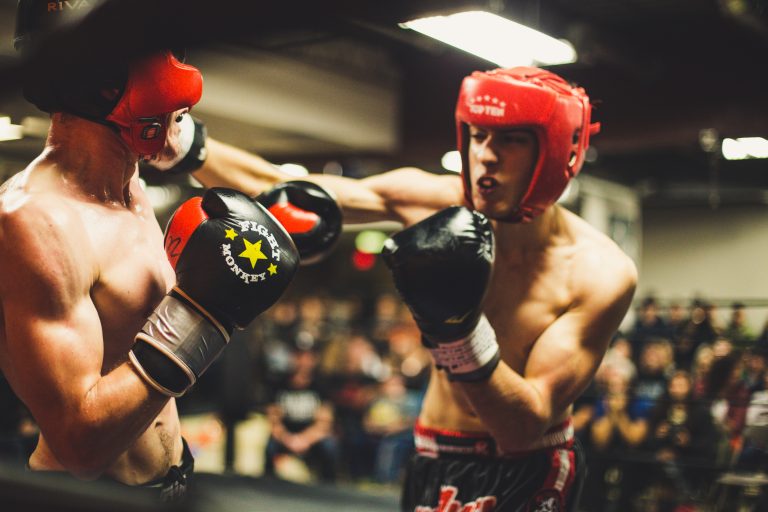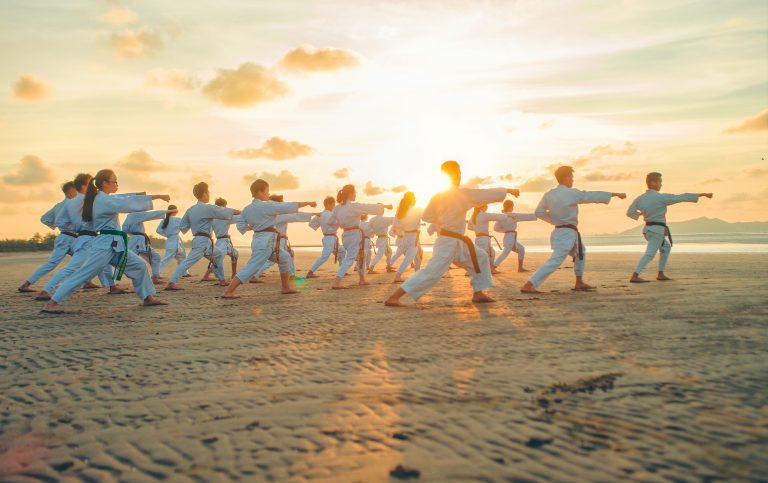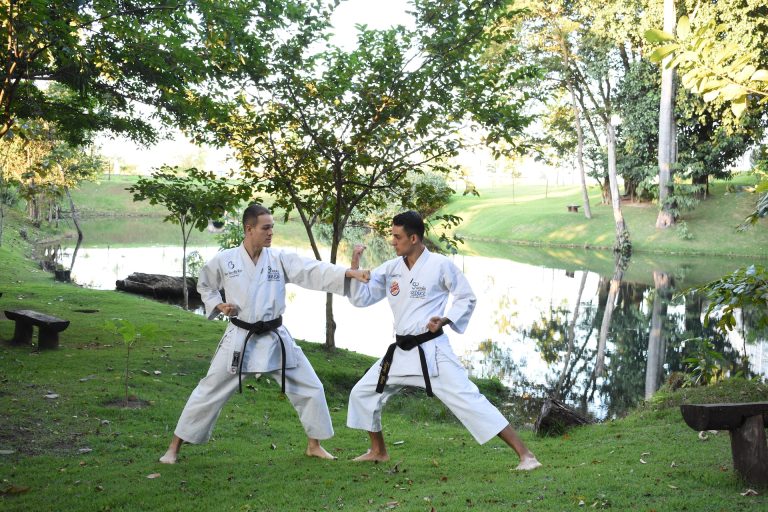Karate Name Liste – Die Bedeutung dahinter
Karate ist ein Kampfsport, der aus Japan stammt und weltweit bekannt ist. Es gibt viele Arten von Karate, die sich in Stil und Technik unterscheiden. Jeder Stil hat seine eigenen Techniken und Namen, die tief in der japanischen Kultur verwurzelt sind. In diesem Artikel werden wir eine Karate Name Liste betrachten und die Bedeutung hinter den Namen erklären.
1. Shotokan Karate
Shotokan Karate ist einer der bekanntesten Karate-Stile der Welt. Es wurde von Gichin Funakoshi, einem japanischen Karate-Meister, entwickelt. Der Name Shotokan setzt sich aus zwei Wörtern zusammen: Shoto, was “Pinienwelle” bedeutet, und Kan, was “Haus” bedeutet. Der Name bezieht sich auf den Namen des ersten Karate-Dojo, das von Funakoshi gegründet wurde, das Shoto-Kan genannt wurde.
2. Goju-Ryu Karate
Goju-Ryu Karate ist ein Karate-Stil, der von Chojun Miyagi, einem Karate-Meister, entwickelt wurde. Der Name Goju-Ryu bedeutet “hart-weich Schule” und bezieht sich auf die Techniken des Stils. Miyagi nahm den Namen von einem Gedicht, das sagt “Der Weg des Karate ist hart und steif wie das Holz, und zugleich sanft und nachgiebig wie das Gras, das im Wind weht”.
3. Wado-Ryu Karate
Wado-Ryu Karate ist ein Karate-Stil, der von Hironori Otsuka, einem japanischen Karate-Meister, entwickelt wurde. Der Name Wado-Ryu bedeutet “Weg des friedlichen Weges” und bezieht sich auf die Philosophie des Stils. Wado-Ryu basiert auf der Idee, dass nicht-gewalttätige Konfliktlösung das beste Mittel zur Erreichung von Frieden und Harmonie ist.
4. Shito-Ryu Karate
Shito-Ryu Karate ist ein Karate-Stil, der von Kenwa Mabuni, einem japanischen Karate-Meister, entwickelt wurde. Der Name Shito-Ryu setzt sich aus den Namen der beiden wichtigsten Lehrer von Mabuni zusammen, Itosu und Higaonna. Shito-Ryu betont die Verwendung von schnellen, schneidenden Techniken und beinhaltet Elemente aus vielen anderen Karate-Stilen.
5. Kyokushin Karate
Kyokushin Karate ist ein Karate-Stil, der von Masutatsu Oyama, einem koreanisch-japanischen Karate-Meister, entwickelt wurde. Der Name Kyokushin bedeutet “die letzte Wahrheit” und bezieht sich auf den Wunsch, den tiefsten Sinn des Karate zu verstehen. Kyokushin betont harte Techniken und Vollkontakt-Kämpfe.
6. Uechi-Ryu Karate
Uechi-Ryu Karate ist ein Karate-Stil, der von Kanbun Uechi, einem okinawanischen Karate-Meister, entwickelt wurde. Der Name Uechi-Ryu bedeutet “Stil von Uechi” und bezieht sich auf den Gründer des Stils. Uechi-Ryu betont die Verwendung von schnellen, harten Schlägen und ist besonders bekannt für seine Anwendung von “Tenshin”, eine Art schnelle Bewegung zur Vermeidung von Angriffen.
Fazit
Die Karate Name Liste zeigt die Vielseitigkeit und kulturelle Bedeutung von Karate-Stilen. Jeder Name hat seine eigene Geschichte und bedeutet etwas Besonderes für diejenigen, die es praktizieren. Obwohl jeder Stil einzigartig ist, betonen alle die Bedeutung von Disziplin, Ausdauer und Selbstbeherrschung.
Karate Name Liste – Die Bedeutung dahinter: FAQs Answered
Karate is a martial art that is popular all around the world. It has a rich history, and names play a crucial role in the practice of this art. In this article, we answer some of the most frequently asked questions about the meaning behind Karate names.
What is the significance of Karate names?
Karate names have deep meaning and are an essential part of the practice of this martial art. They are used to identify various techniques, katas, and styles of Karate. Understanding the meaning behind the names can help practitioners better understand the techniques and their purpose.
What do the different Karate styles names mean?
There are various Karate styles, and each has its name. Here are some of the most popular Karate styles and their meanings:
Shotokan Karate
Shotokan Karate is one of the most popular Karate styles worldwide. The name Shotokan is derived from the pen name of Gichin Funakoshi, the founder of Shotokan Karate. The word “shoto” means „pine waves,“ which refers to the sound the wind makes through pine trees.
Goju-Ryu Karate
Goju-Ryu Karate is a traditional Karate style that originated in Okinawa. The name Goju-Ryu means „hard-soft style,“ which refers to the combination of hard and soft techniques used in this style.
Wado-Ryu Karate
Wado-Ryu Karate is a Karate style that combines elements of Jujutsu with traditional Karate techniques. The name Wado-Ryu means „way of harmony.“ This name reflects the style’s emphasis on using one’s opponent’s strength against them.
What do different Karate techniques names mean?
There are numerous Karate techniques, and each has its name. Here are some of the most popular Karate techniques and their meanings:
Choku-Zuki
Choku-Zuki is a Karate technique that involves a straight punch. The name Choku-Zuki means „straight punch“ in Japanese.
Empi
Empi is a Karate technique that involves an elbow strike. The name Empi means „flying swallow“ in Japanese.
Ura-Mawashi-Geri
Ura-Mawashi-Geri is a Karate technique that involves a spinning roundhouse kick. The name Ura-Mawashi-Geri means „reverse round kick“ in Japanese.
What do the different Kata names mean?
Kata is a term used in Karate to describe a choreographed sequence of movements. Each Kata has its name, and here are the meanings behind some of the most popular Kata names:
Heian Shodan
Heian Shodan is a Kata that is taught to beginners in Karate. The name Heian Shodan means „peaceful mind first level“ in Japanese.
Bassai Dai
Bassai Dai is a Kata that is taught to intermediate and advanced Karate practitioners. The name Bassai Dai means „to penetrate a fortress big“ in Japanese.
Tekki Shodan
Tekki Shodan is a Kata that is taught in many Karate styles. The name Tekki Shodan means „iron horse first level“ in Japanese.
What is the meaning of Karate belts?
Karate belts have different colors, and each color represents a different level of proficiency. Here are the most common Karate belt colors and their meanings:
White Belt
The white belt symbolizes innocence and humility. It represents a beginner’s level of proficiency.
Yellow Belt
The yellow belt represents the first stage of progress. It symbolizes the seed that is beginning to sprout.
Green Belt
The green belt represents growth and development. It symbolizes the plant as it grows through the ground.
Black Belt
The black belt represents the highest level of proficiency in Karate. It symbolizes the darkness before dawn, where the practitioner is ready to face their greatest challenges.
Conclusion
Karate names have deep meaning, and understanding their significance can help practitioners better understand the techniques and their purpose. Knowing the meaning behind Karate names can also help individuals choose the right Karate style and find the best dojo for their training. Keep exploring and learning about Karate to deepen your knowledge and appreciation of this martial art.
Inhaltsverzeichnis






